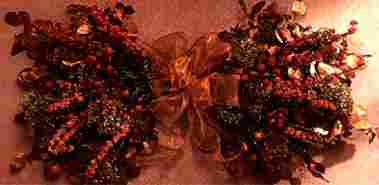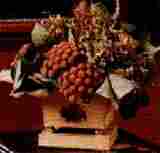| * Remove the lowest leaves from a stems, cut the stems to even lengths
and using a rubber band, bind the bottom ends together.
* Whole rosebuds can be hang upside down in bunches of five to six roses
with leaves intact in a warm airy place to dry. Strips the lowest leaves
from the stalks before tie them in bunches.
* Stretch a chain across a room just below the ceiling.(Plant materials
hooked through a chain link won't slip as they might on a slick wire).
Hang the flowers and herbs upside down in an airy, dry, warm and dark place
such as well-ventilated attics or large closets.
To avoid crushing, do not put to much herbs or flowers
in a bunch.
Avoid direct sunlight which will cause the flowers
to fade.
* It takes between one to three weeks for flowers to dry. The length
of the drying period will vary, depending on the temperature and humidity.
Herbs need between one to two weeks to dry. Check the plants every few
days, because if they remain in drying area to long, they my become to
dry for use. Dried materials should feel papery and firm, not limp or damp.
Many garden herbs and flowers dry extremely well.
* Store your dried materials in covered boxes, airtight containers or
in brown paper bags. Keep flower and herb groups separate and be sure to
label these containers. Transfer prepared materials to a cooler location
that remains dry and dark.
* To dry plants and flowers of which are heavier than their stems (for
example straw flowers, chrysanthemums etc.) use the plastic plant trays
found at hardware stores or greenhouses. Position the trays so their bottom
surfaces are several inches above the floor and drop the flower stems into
the holes. The flower heads, which won't fit through the holes, will dry
in an open
position.
* To dry flower heads just spread them on sheets of newspaper and leave
them in a warm airy place to dry completely.
* Use clothes-drying racks to dry short-stemmed herbs, bundle them and
hang them on racks.
* The dried material will have a natural fragrance but this will soon
fade if you do not use a fixative. Orris root is one of the best for pot
pourri, but you can also use other spices such as cinnamon, mixed spice,
nutmeg, cloves, orange peel, lemon peel or sea salt.
* Essential oils are another vital fixative which will add depth and
intensity of fragrance to your dried material. Avoid contact with hands
because oil has a very strong perfume. Store the oils in the glass bottles,
never in plastic bottles. Use one drop at a time because if you use to
much it will upset the real fragrance.
* Electric dehydrators are especially handy for drying slices of fruits
such as oranges, lemons and apples.
* If you need some dry material instantly you can use your microwave
oven for making what you need. To dry herbs or flowers in the microwave
oven you will need SILICA GEL. Silica gel is a substance used to dry delicate
flowers too, such as roses or calendula, as it preserves their forms and
colors well. Silica gel can usually be found in craft stores. It is very
simple to dry flowers with a silica crystals, just use one microwave safe
container with a 1" (2,5 cm) thick layer of the silica crystals and place
your flowers on the top allowing about 1- inch of space around the sides
and between each flowers. Put another an inch layer on the top of flowers
and then microwave on cca 50 % power for approximately 2-3 minutes, depending
on the type of your microwave and flowers. It is better to check the material
progress an add some more times if needed. Flowers and leaves often have
different drying times, microwave them separately for better result. Never
use silica gel containers for preparing food after you use them for drying
flowers, because they often absorbs pesticides from plants as they dry. |









